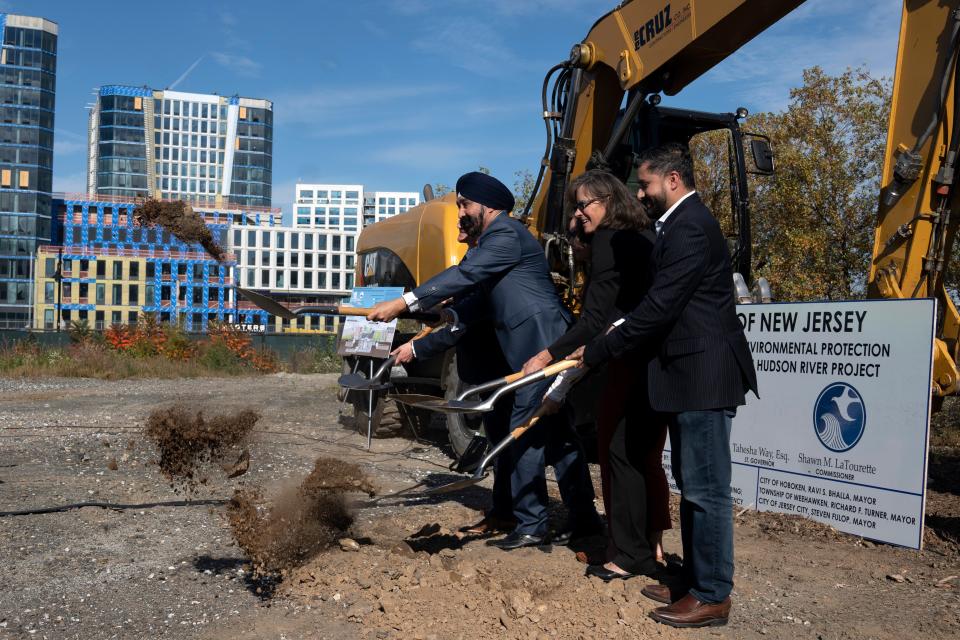Remember Sandy? $300M flood resiliency projects break ground in Meadowlands and Hoboken
Almost 11 years to the day since Superstorm Sandy struck New Jersey, state and local leaders broke ground Wednesday on two flood resiliency projects that have been in the making for years.
The developments include building floodgates in the Hoboken area and upgraded drainage in the Meadowlands region — areas vulnerable to flooding — to combat severe impacts of storm surges and rising sea levels. Affected communities include Little Ferry, Carlstadt, Moonachie, South Hackensack and Teterboro and parts of Jersey City and Weehawken.
The contracts total nearly $298 million, funded largely by the Rebuild by Design competition launched by President Barack Obama’s Hurricane Sandy Rebuilding Task Force in 2012.
Hoboken area builds water-storing parks, barriers
The Rebuild by Design-Hudson River project received $251 million, the bulk of those funds. Construction plans involve building barriers to resist high tides and storm surges. That includes 9,000 linear feet of floodwall, floodgates and resistance structures, like berms and levees.
Parts of Hoboken were developed on previous marshland and a filled-in island, according to the project’s Rebuild by Design webpage. That makes these low-lying swaths susceptible to flooding when an inch or more of rain per hour falls. Storms have become more frequent and intense as a result of climate change, raising concerns when they are combined with rising sea levels in Hoboken and surrounding communities.
New Jersey leaders pitched in an additional $100 million for flood mitigation infrastructure at the new Harborside Park in Hoboken, where Wednesday’s groundbreaking took place — part of a series of new or expanded green spaces, including Southwest and Northwest Resiliency Parks, designed to capture, store and filter stormwater in the city.
On the 11th anniversary of Sandy, we mark a turning point in NJ as we break ground on the RBD Hudson/Meadowlands projects which will protect two areas that are extremely vulnerable to the impacts of climate change.@shawnlatur @CityofHoboken @RaviBhalla @NJDCA @RajMukherji pic.twitter.com/C6gHpYMwS9
— New Jersey Department of Environmental Protection (@NewJerseyDEP) October 25, 2023
This spring, Hoboken completed an expansion and development of the Southwest and Northwest Resiliency Parks. These green spaces can store and filter 1 million gallons of water.
Hoboken officials plan to double the acreage and increase stormwater detention capacity at the Southwest Resiliency Park by the end of the year. A third park is at Seventh and Jackson streets. Local leaders are also in the midst of the public planning process for a fourth resiliency park, expected to be at 800 Monroe St. The four parks together would bring the city’s resiliency park total to 10 acres.
Meadowlands region pursues scaled-down resiliency efforts
Rebuild by Design-Meadowlands got the remaining $45.6 million, which went to a contract with Union Paving & Construction. Its team will improve drainage in the Losen Slote Creek watershed by installing a second pump station and force main in Little Ferry. Wednesday’s event marked the start of construction on the pump. Union will also remove a decommissioned tide gate foundation that blocks flow within the creek.

Superstorm Sandy wreaked havoc in the Meadowlands region, where a massive storm surge pushed a deluge of water from the Hackensack River into streets and homes. Thousands of people were evacuated, and houses, businesses and cars were severely damaged.
About a year after Sandy, leaders of the Meadowlands communities affected by the storm began to lobby for more funds to build up the region’s defenses against similar storms.
Little Ferry Mayor Mauro Raguseo said that since the Rebuild by Design project was announced there have been 50 to 60 meetings and community input sessions hashing out the details.
The initial cost estimate for the project, which would have involved surrounding 14 towns with earthen walls called berms, adding a transportation system and building millions of square feet of commercial and industrial space, was well over $1 billion. The project was eventually scaled back considerably.
Construction in Little Ferry will get underway within the next couple of weeks and will likely take about two years to complete.
“There will be detours, there will be inconveniences, there will be noise, but at end of the day, the final completed project will have a big impact on flood control in Little Ferry,” Raguseo said. “We are thrilled that after all these years of meetings and lobbying and planning we are finally going to see the start of the project.”
This article originally appeared on NorthJersey.com: Hurricane Sandy-inspired flood project begins in Meadowlands

